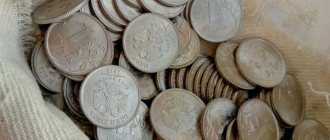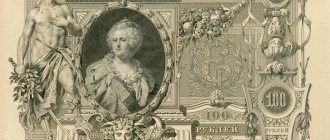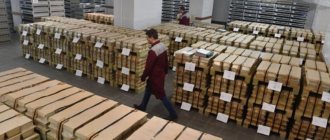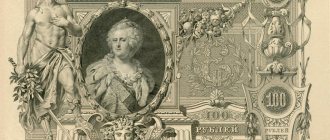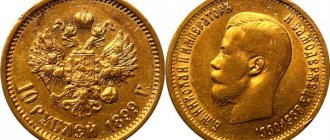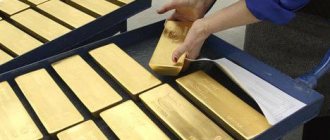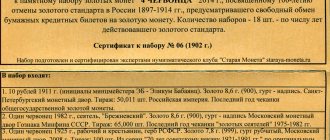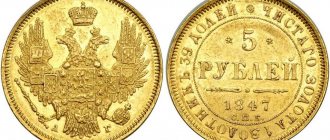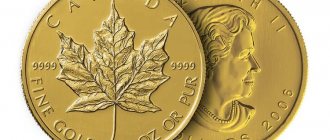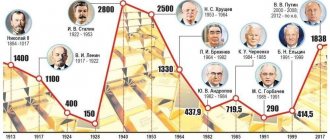Post updated: May 28, 2020
Most countries' currencies are not backed by gold reserves. There is also no link between the ruble and gold. The gold reserve available in Russia is not enough for this: even if the ruble backing is implemented, it will amount to about four percent. The only opportunity to do this is only in cases of global changes in the economy, but it is very difficult for the state to decide to take such drastic actions.
Nowadays, the ruble is not tied to gold.
How was the ruble secured?
The ruble as a monetary unit was introduced into circulation by Peter I and was minted from silver at that time. The raw material for the coins itself confirmed its status as a solvent unit. Then banknotes appeared in circulation, which very quickly depreciated and were not trusted even within the country. The only attempt to peg the ruble to gold was made at the end of the 19th century and ended very successfully.
Gold coins came into circulation and could be freely exchanged for paper money. The 1:1 ratio was not violated. In the pre-revolutionary period, the ruble's supply of precious metals reached 150%. This entire system, which was finally put into operation, collapsed after the revolution, when a political crisis reigned in the country and the economy was practically destroyed.
Ruble from the era of Peter Perov.
The fact that a currency is endowed with resources or a state reserve is usually assessed positively. According to world practice in recent years, a currency can be stable even without collateral. An example is the euro. This currency is not tied to the national economy, much less has any backing, but is quite successfully used and converted.
The Russian ruble is not backed by gold. Among the factors that provide the national currency, analysts name a large amount of foreign currency - the receipt of dollars from the sale of energy resources. Modern realities of geopolitics and economics force government authorities to think about stabilizing the ruble by other means. Is it possible to introduce backing of the Russian ruble in gold again?
Cash and item lotteries
Another effective way to replenish the military treasury was the all-Union lotteries. During the Great Patriotic War, a total of four such draws were held.
In 1941, the First cash and clothing lottery was announced, the cost of a ticket was 10 rubles. A lot of money was up for grabs: 10 wins of 50 thousand, 40 of 25 thousand, 200 of 10 thousand and 1,750 wins of 5 thousand rubles.
1941 lottery ticket
en.wikipedia.org
In addition to money, valuable things were raffled off: ladies' astrakhan coats, arctic fox and fox furs, gold-plated watches, silver cigarette cases, clothes, shoes and much more.
For a ticket to the Second lottery you had to pay 20 rubles, for the Third - 25, for the Fourth - 25 or 50 rubles.
Is a return to the gold standard possible?
In the context of sanctions from Western countries and comprehensive pressure on the Russian economy, the idea of abandoning payments in dollars is heard more and more often and more insistently. As an analogue, a currency system based on collateral in the form of yellow metal is proposed.
The introduction of sanctions against Russia is pushing for a discussion of the gold backing of the ruble.
Some actions of the Russian authorities indicate that work in this direction is underway. A weak ruble becomes a threat to the development of the domestic economy, prompting the Central Bank to raise rates. In the short term, the weakening of the ruble will not bring anything good, and the Central Bank of the Russian Federation cannot endlessly raise rates to protect the currency.
The situation is complicated by the sanctions imposed against Russia: the ruble has fallen over the past year against the dollar by more than 30%. The pricing of the ruble in American dollars occurs through foreign exchanges, which also does not strengthen Russia’s position. A currency war threatens serious economic problems, so many experts express support for the option of returning to the gold standard.
Options for creating gold collateral
How can the ruble be pegged to gold? With the Russian economy at 2 trillion. US dollars, external public debt is about 378 billion. Foreign exchange reserves are approximately 429 billion dollars, of which about 45 billion are stored in the form of real precious metal. The budget deficit will be about 1% of GDP in 2015. These conditions suggest that the gold standard can be introduced and successfully used for a long time. The two main conditions for its success will be strict adherence to budget discipline and strict control of the credit sector.
By setting ruble-to-gold conversion rates, the Central Bank will be able to use all its powers to manage currency liquidity. Authorities will no longer be limited to gold buying and selling transactions.
One option could be the issue of coupon bonds, the yield on which will be tied to gold.
Managing the ruble exchange rate under the gold standard will cause some difficulties, but with the competent work of the Central Bank, they can be resolved. Lending growth will have to be limited, otherwise the entire created system will be at risk. The massive conversion of rubles into precious metals can be regulated by withdrawing the currency from circulation.
In general, pegging the ruble to gold is quite possible with the implementation of some economic reforms.
The main threat to the gold backing of the ruble is the central banks in London and New York, which can buy rubles and present them for exchange for the yellow metal. But this possibility can also be limited by introducing special rules.
It is unclear whether the ruble will be backed by gold or other collateral in the near future. The assessment of the consequences for the country's economy is as follows: with the introduction of the gold standard, the ruble should stabilize. This will mean that the increase in the cost of living will slow down markedly, and domestic savings will begin to grow. Ideally, this could lead to political consequences: lower government spending on social security, the establishment of monetary stability and low taxes. All this should create conditions for the creation and further development of a strong production basis for the domestic economy.
Adventures of a chervonets in the Land of Soviets
In the first years after the Civil War and the era of War Communism, the Soviet government struggled with desperate inflation without much success. A monetary surrogate, pieces of paper called “Sovznaki,” was issued continuously and with an ever-increasing number of zeros.
A popular refrain among the population was the following: “I run into the buffet - there’s not a penny of money!” Exchange ten million!”
There was no time for the widespread introduction of the golden chervonets. Moreover, in the bins of the Motherland it was a hot mess: all the available gold went to the West - to purchase the most necessary things for the destroyed national economy. But still, in 1923, a small batch of gold chervonets was released into circulation. Needless to say, the coins, once in the hands of fellow employees, immediately went into the “boxes.” Subsequently, they no longer began to experiment with the “gold standard” in the USSR.
It is interesting that a gold chervonets in Soviet Russia in the 1920s was cheaper than a paper banknote of the same denomination. That is, officially exchanged at the rate of 10 to 9.5. Let us recall the mise-en-scène from “12 Chairs”, the conversation between Father Fyodor Vostrikov and archivist Korobeinikov. Minutes earlier, deceived by the brilliant Ostap Bender, the enraged keeper of orders demanded an astronomical 100 rubles for information about General Popova’s headset (who had never had a damn thing in him). “Is it okay that I have gold tens?” - Father Fyodor hurried, tearing the lining of his jacket. “I’ll accept it according to the exchange rate. Nine and a half each. Today’s exchange rate,” answered Korobeinikov.
Critical view
Some experts view the return to the gold standard critically. The history of economics knows positive examples of such government actions, but now is a completely different time. Factors that correspond to the actual state of the economy should be taken into account.
The transition of the world's major economies to being backed by gold will be the moment of collapse of the system based on settlements in American currency.
Monetary-type inflation will create uncertainty risks for capital investments and effectively destroy savings, which are vital for financing. Some believe that currency management cannot lead to economic growth.
But the real situation is that if the countries with the largest economies in the world begin the transition to the gold standard, this will mean one thing - the end of the dollar-based currency system. Whether the ruble will be tied to physical gold or not depends on the decision of government authorities. The decision must be made taking into account the size of actual budget expenditures and the presence of long-term obligations.
Such steps by individual countries will lead to a split into two camps: some will use the gold standard, while others will not be able to do this or simply will not want to take this step.
China's policy of increasing its gold reserves and increasing production volumes could make the yuan an international currency and a competitor to the dollar.
Among those states that can do this and are systematically preparing for the introduction of the gold standard is China. The demand for gold from China in recent years has always been one of the highest; government policy is aimed at accumulating gold reserves and stimulating private investment in the metal. These measures allow the Chinese economy to protect itself from external and internal negative factors.
Chinese authorities often blame American policy for the current situation in the gold market. The US is using its huge gold reserves to suppress other currencies in order to maintain the dollar's leadership. Further strengthening of the Chinese economy may allow the internationalization of the yuan, which will become a competitor to the dollar.
Gold has historically played an important role in protecting the economic security of the state. The introduction of a gold standard, taking into account all the accompanying restrictions, can really save the country's economy in times of crises and wars.
There is another opinion regarding the introduction of the gold standard. Economists say that such a monetary system will not be sustainable, since the supply of money will be controlled not by banking institutions, but by mining companies. The price of gold will constantly change, especially depending on the discovery of new deposits of the precious metal, and inflation will be replaced by deflation.
Of course, the volume of production of the yellow metal will affect the economy, but not as dramatically as the “printing press” of the US Federal Reserve.
This development of events is possible, but has several open questions. The rate of gold production is growing much slower than the US Federal Reserve's money printing is increasing. Such actions always lead to inflation and undermine the stability of the monetary system. Under the gold standard, it is simply impossible to make money indefinitely.
Occupation money
In the occupied territories of the USSR, the Nazis did not prohibit the circulation of Soviet rubles and chervonets.
Moreover, as Napoleon once did, they put into circulation the money seized during the offensive from banks, government agencies and shops. And these were large sums - thousands and millions of chervonets.
Reichsmarks
en.wikipedia.org
Reichsmarks
en.wikipedia.org
Reichsmarks
en.wikipedia.org
Special Reichsmarks were also printed for the occupied territories of the USSR, and in Ukraine and parts of Belarus they also printed karbovanets.
Due to the circulation of three types of banknotes in these territories, spontaneous exchange rates developed. The better the Nazis did at the front, the higher the rate of the occupation Reichsmark, and vice versa.
Military stamps and coupons
To cover military and occupation expenses, the allies of the anti-Hitler coalition introduced a special currency in Germany in 1944 - military marks.
They were issued by the Allied Military Command of the Western Powers. Clichés for banknotes, paper and ink were ordered in Washington, and printing was carried out at various enterprises, including in the USSR.
Military stamps 1944
en.wikipedia.org
Military stamps 1944
en.wikipedia.org
Military stamps 1944
en.wikipedia.org
One mark could be exchanged for 50 kopecks, 10 US cents or 1/40 of a pound sterling. They were in circulation until 1948.
Military personnel of the allied armies of the Anti-Hitler Coalition received special money - coupons. You could use them to drink coffee, eat a sandwich or buy a pack of cigarettes.
Coupon for allies of the Anti-Hitler Coalition
en.wikipedia.org
They were kept in special books, where 60 such coupons were placed.
